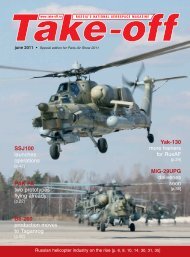Create successful ePaper yourself
Turn your PDF publications into a flip-book with our unique Google optimized e-Paper software.
the programme, enhancing the UAV’s<br />
performance and fitting it with sophisticated<br />
gear. However, if the programme goes ahead,<br />
it looks like it will follow the direction<br />
traditional to Tupolev’s Reis and Strizh air<br />
recce UAVs, because the Tu-300 is far <strong>off</strong> the<br />
current international UCAV mainstream as far<br />
as its concept, including take<strong>off</strong> by launcher<br />
and landing by parachute, is concerned.<br />
The Yakovlev design bureau’s Proryv<br />
(Breakthrough) programme is much more<br />
on a par with the spirit of the age. Having<br />
a wealth of experience in small UAVs (e.g.<br />
several types of Pchela (Bee) drones have<br />
been tested, combat proven, produced and<br />
operated by the Russian military), Yakovlev<br />
went public with its plans of developing a 10t<br />
combat UAV several years ago. The Proryv-<br />
U UCAV was to be developed as part of a<br />
commonised UAV family also comprising<br />
the Proryv-R recce UAV and Proryv-RLD<br />
airborne early warning UAV. To slash the cost<br />
and time of development, systems proven on<br />
the Yak-130 combat trainer were to be used,<br />
first and foremost, the engine, remote control<br />
system, aircraft systems, special airborne<br />
equipment, etc. According to the picture<br />
at Yakovlev’s Web site, the commonality<br />
between the Proryv UAV and Yak-130 may<br />
be 40 per cent. Yakovlev’s Chief Designer<br />
Yuri Yankevich <strong>off</strong>ered detailed enough<br />
information and diagrams of the Proryvfamily<br />
drones in a special issue of the Polyot<br />
scientific and technical magazine timed to<br />
the 100th anniversary of A.S. Yakovlev in<br />
March 2006.<br />
The strike variant is planned to be a stealthy<br />
tailless flying wing with internal payload<br />
carriage, a single engine and an air intake<br />
placed on top the front fuselage. Its take<strong>off</strong><br />
weight is estimated at 10 t, payload (missions<br />
systems and weapons) at 1–3 t, maximum<br />
speed at 1,100 km/h, service ceiling at<br />
16,000 m and endurance at six hours. 60<br />
to 70 per cent common with the combat<br />
variant, the recce and AEW versions differ in<br />
avionics, a higher wing aspect ratio and the<br />
design of their tail unit modules.<br />
In summer 2005, the Yakovlev design<br />
bureau, part of Irkut Corp., became known to<br />
have <strong>off</strong>ered its long-time Yak-130 programme<br />
partner, Alenia Aermacchi (subsidiary of<br />
Finmeccanica), to pool efforts in advanced<br />
UAV development, with the Russo-Italian<br />
relevant agreement signed during MAKS<br />
2005. At the Le Bourget air show in June<br />
this year, Irkut’s President and Yakovlev’s<br />
Director General Oleg Demchenko said for<br />
the record that the parties were about to<br />
launch practical work in this field. “Two<br />
years ago, Italian companies Finmeccanica<br />
and Alenia and we signed an agreement<br />
on deriving an unmanned aerial vehicle<br />
www.take-<strong>off</strong>.ru<br />
Tupolev Tu-300 UAV prototype at MAKS airshow in 1990s<br />
Skat UCAV and MiG-<strong>29</strong> fighter dimensions<br />
comparison (drawing by Alexey Mikheyev)<br />
military aviation | project<br />
Yakovlev Proryv UAV family being designed<br />
using Yak-130 combat trainer technologies<br />
(drawing by Alexey Mikheyev)<br />
take-<strong>off</strong> november 2007 39<br />
Yevgeny Yerokhin




